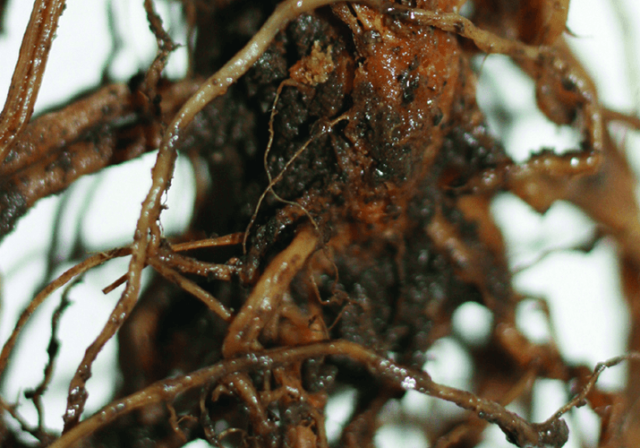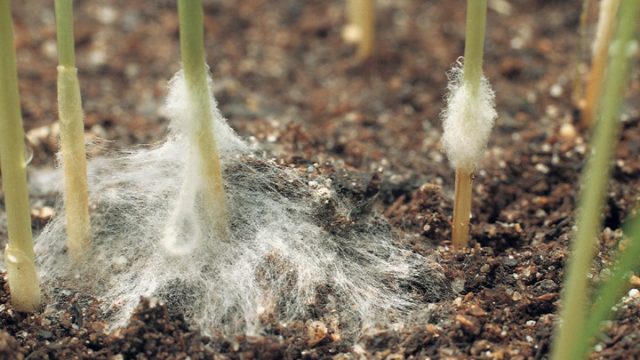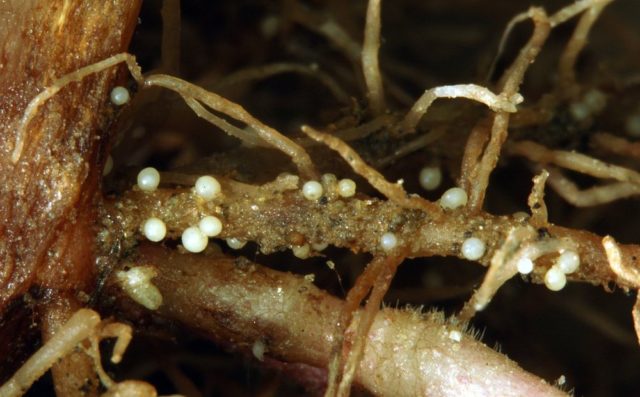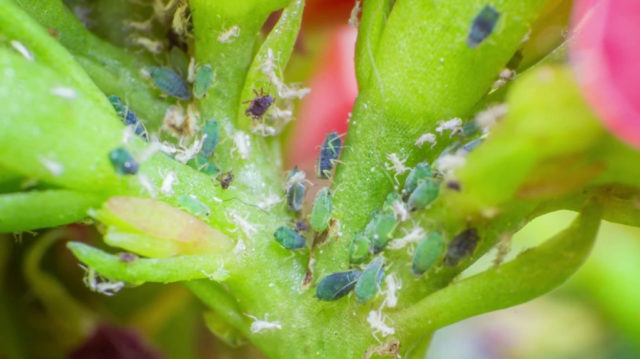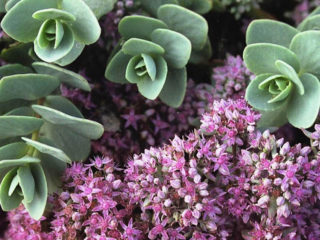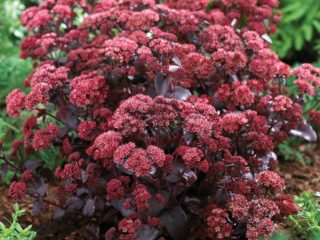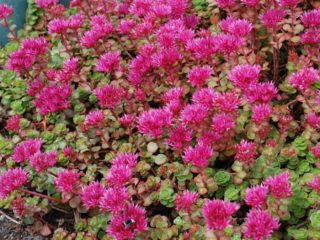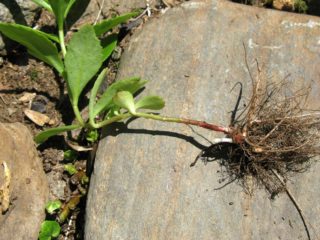Content
Morgan's sedum is a very decorative-looking plant that can forgive its owner's forgetfulness and endure a long period of “drought.” Refers to succulents that are adapted to hot, dry climates and store water in their own tissues.
All representatives of this group are very beautiful when young, but as they grow, they can lose leaves, remaining with a bare stem. These plants include the “rose” echeveria. Sedum, in contrast, with proper care retains foliage, which gives it an attractive appearance.
Description of the plant
Morgan's sedum is a succulent, that is, a plant adapted to living in regions where drought is replaced annually by the rainy season. Belongs to the Crassulaceae family.Like other representatives of this group, sedum survives without moisture for almost 6 months after it “drinks” plenty of water during rainstorms. Morgan's sedum was discovered in dry areas of Mexico. In nature, succulents often grow on steep rocky cliffs, anchoring themselves with roots in crevices.
Its official name in Latin is Sedum morganianum. In Russian transcription - Morgan's sedum. Due to its appearance, the succulent has received many other names. And in all of them there is the word “tail”:
- horse;
- donkey;
- burro (also “donkey”, but in Spanish);
- monkey;
- lamb
The association with the tail is caused by the long, hanging stems of sedum, “braided” with leaves.
Morgana sedum is a perennial plant with drooping stems. The length of the latter in nature reaches 100 cm. Very fleshy, slightly flattened leaves reach 2 cm. Thickness is 5-8 mm. The cross section is an irregular oval.
The leaves grow on the stem in a circle and are located close to each other. This actually gives the appearance of blue-green scaly tails hanging from a flower pot.
In nature, succulents bloom every year after the end of the rainy season. But at home, Morgana sedum, even with good care, very rarely forms buds. But if this has been achieved, the tail acquires a brush of several peduncles with 1-6 flowers. The color of the petals ranges from pink to bright red.
In reality, the flowers of the original form of the sedum Morgana succulent do not look as attractive as in professional photographs
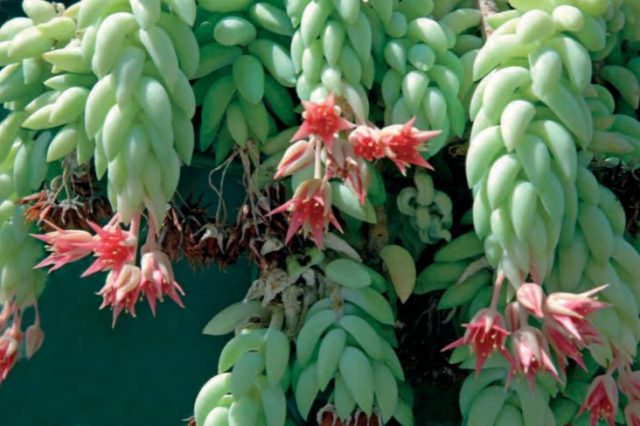
Peduncles are formed only on the longest stems and in quantities of up to 6 pieces
After “monkey tail” began to be kept as an ornamental plant, 20 varieties were bred from the wild form of Morgan’s sedum: sedum burrito “donkey’s tail”, sedeveria “giant donkey’s tail”, Adolph’s sedum, Stahl’s sedum and others.
The first two are the most interesting.
Sedum burrito "Baby Donkey Tail"
It is a dwarf variety of "monkey tail", growing to about half its size. Good for small spaces. Its leaves are about half the size of a donkey's tail, giving it a very cute and whimsical appearance. The color of the leaves is light green without a matte coating. Care for this plant is the same as for the original form of Morgan's sedum.
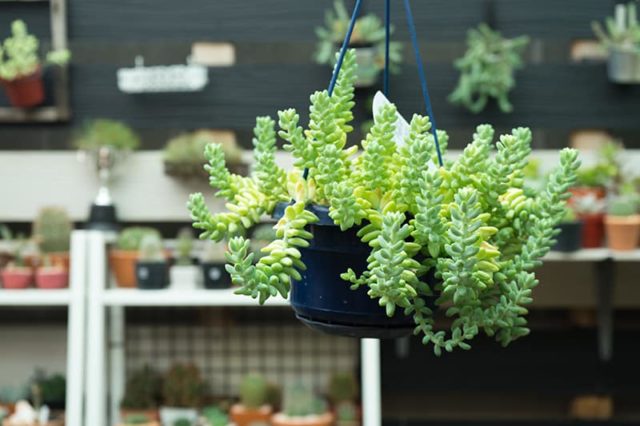
It is more convenient to keep a “donkey’s tail” in a small room.
Sedeveria "Giant Donkey's Tail"
This plant is a hybrid of two different succulents: Sedum Morgana and Echeveria. The leaves are pointed and large. The shape and size are partly inherited from Echeveria. They are located in the same way as in sedum. As a result, the stem covered with such foliage looks very powerful and thick. Some of the "tails" of this plant can grow upright.

"Giant Donkey's Tail" looks good on an exterior wall, but would be out of place in a small room.

Thanks to hybridization, sedeveria has an interesting flower color: yellow petals and a red core
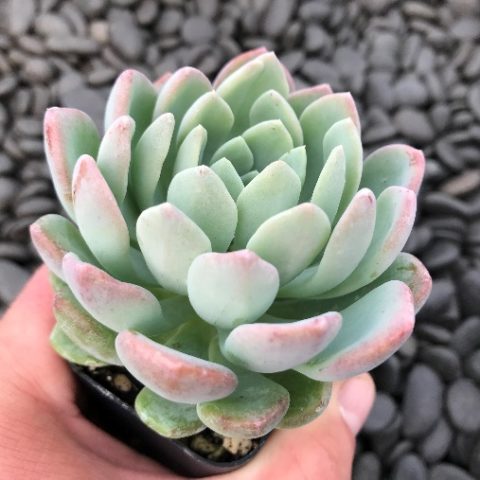
Echeveria is one of the parent forms of Sedeveria
How fast does Sedum Morgana grow?
Like any succulent, Morgana sedum takes root easily and quickly. But the owner of a sedum may have problems growing a long vine. Even in nature, these plants do not grow very quickly. At home they slow down even more.
But slow growth can also be a boon for the grower.Sedum Morgana does not require annual replanting, as is the case with fast-growing species. It can be kept in the same small pot for several years. This is what allows you to grow beautiful “lashes”.
Is Morgan's poisonous sedum or not?
Monkey's tail is a non-poisonous plant. But it is often confused with the overgrown myrtle-leaved spurge. The juice of the latter leaves burns on the skin. Although milkweed is also often planted as an ornamental plant, handling it requires care.
On the left in the photo is spurge, on the right is Morgan's sedum:
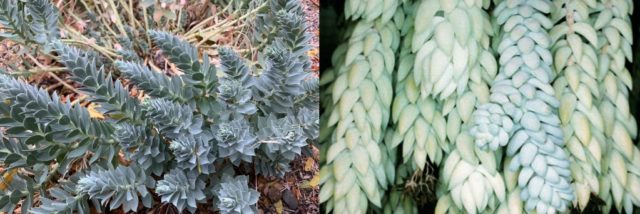
If you look carefully, it is difficult to confuse these two plants: milkweed has flat leaves with pointed tips, while sedum has “swollen”, drop-shaped leaves
It is even more difficult to confuse these two species in the flowering state. Morgan's sedum flowers have a bright color and resemble either a small lily or a half-blooming tulip.
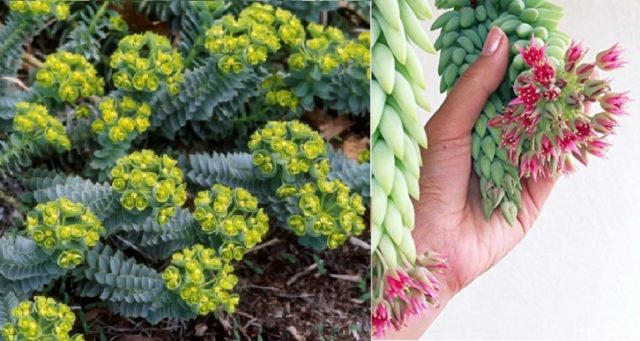
Milkweed (on the left) has nondescript yellowish-green “plates”
Flowering at home
Succulents are stingy when it comes to flowering. At home, it is almost impossible to achieve this phase of the growing season from them. And they don’t need flowers to survive. They reproduce well by leaves and cuttings.
You can try to cause sedum to bloom, but to do this you will have to reproduce the natural conditions of its existence. The main requirement for flowering is not to move the sedum from its permanent place. Then it's a matter of luck. But if the sedum blooms, it will do so in the summer.
Plant meaning
Unlike the Crassula ovata, which is also called the money tree, the Morgana sedum did not have time to acquire esoteric significance. There is only a version that in ancient times its leaves were used as a local anesthetic, applied to wounds. Hence the Latin name “sedum”. There are 3 versions of the origin of this name:
- sedare, that is, “pacification”;
- sedere – “to sit”, as many types of sedums creep along the ground;
- sedo – “I sit”, due to the fact that some succulents grow on steep walls.
But the importance of Morgan's sedum in the decorative design of a winter garden is difficult to overestimate. With proper care, this plant can decorate any composition.
Peculiarities of reproduction of Morgan's sedum
Even if Sedum Morgana reproduces by seeds, no one has seen it. But it does an excellent job of rooting broken pieces of stems and fallen leaves. The most common practice of propagating Morgan's sedum is using leaves. To do this, just collect them and place them in a pot with prepared soil. After which the soil is moistened, and the leaves are gently pressed into the wet soil.
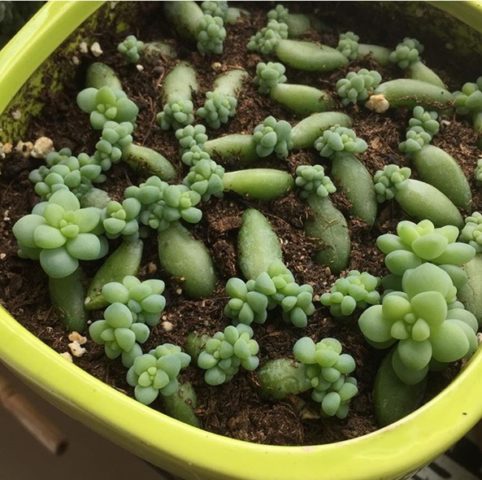
Sedum foliage easily takes root and sprouts
The second method of propagation is cuttings. The sedum stem is cut into pieces 5-7 cm long. The lower part is cleared of leaves and the planting material is left to air dry for 24 hours. Dry in the dark. The “bare” part of the finished sections is sprinkled with earth and watered. Keep the soil slightly moist until the Morgana sedum takes root. This takes about 2 weeks. Sometimes cuttings are placed in water until roots appear. But in this case, you need to make sure that the plant does not rot.
Propagating sedum by cuttings is less convenient than by leaves. Therefore, the cut tops of the old stem often act as cuttings. Simply because the leaves from the remaining part have already fallen off on their own and the flower looks ugly.
Fine red hairs often appear on bare stems. These are aerial roots, with the help of which sedum catches summer dew in natural conditions. You can cut off the top with such a stem and immediately plant it in another pot. Rooting will be easier than with cuttings.
The succulent branches very reluctantly. Pinching the top does not guarantee the appearance of side branches, but it disfigures the flower. Therefore, the best way to quickly get many stems hanging from one pot is to plant the right number of cuttings or leaves there.
If there is nowhere to rush, you can wait until the root system grows. The stems of sedum hardly branch, but it produces new shoots from the root. The third method of reproduction is based on this ability - dividing the bush.
The procedure is the same as for most colors:
- remove the sedum from the pot;
- divide the root into several parts so that there is at least one stem;
- lightly shake off the root part from the soil, but you don’t have to clean it;
- plant all the parts in pots.
The appearance of Morgan's sedum after this method of reproduction will most likely be as in the photo below:

It is best to divide the sedum during transplantation into a new pot; during this procedure, a very large number of leaves fall off
Optimal growing conditions
The ideal temperature for sedum is in the range of 18-24 °C. The succulent needs a lot of sunlight, so the pot with Morgana sedum should be positioned so that the sun falls on the stems for at least 4 hours a day.
Sedum should not be placed too close to windows and doors. In summer, the sun will burn the leaves through the glass, and in winter, cold air will come through the cracks.
At home, the succulent goes into a dormant state in winter. At this time, reduce watering and lower the air temperature by 10 °C.
Planting and caring for Morgan's sedum
Although sedum growing in nature is considered an unpretentious plant, at home the situation is different. And those qualities that help a succulent survive on rocks can be harmful at home. Due to the adaptive characteristics of Morgan's sedum, you need to be careful in caring for it when growing it at home.
The photo shows Morgan's sedum with improper care and poor choice of planting site:
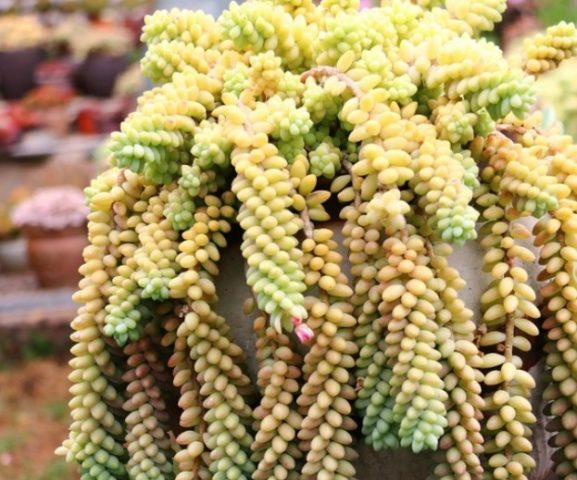
Leaf discoloration is caused by excess direct sunlight during midday.
Preparing containers and soil
Morgan's sedum does not require a large amount of soil, and its roots do not penetrate to great depths. Therefore, in the case of this succulent, you can get by with a small container. But you also need to take into account that the soil in the pot must allow water to pass through well. Usually the pot is filled with soil for cacti or a mixture for flowers, but mixed with sand in a 1:1 ratio. Another option: take one part each of flower soil, sand and agroperlite.
A layer of expanded clay or pebbles must be poured onto the bottom of the container. If the pot will stand in a tray, after watering the excess liquid must be drained.
When planting a plant in open ground, you need to consider a drainage system. It is best if Morgan's sedum grows on a small hill. Large pebbles should be placed under the soil layer. A drainage ditch is dug around the planting site.
Landing algorithm
Depends on what the owner of the sedum plans to plant. If it's just leaves:
- fill the pot with drainage and soil mixture;
- place the leaves on top;
- press firmly to the ground;
- water.
The cuttings are planted in holes, sprinkled with soil and watered. A container with soil is prepared in the same way as for leaves.
Caring for Morgan's sedum at home
Hang it where the morning or evening sun will hit, water it occasionally, fertilize it and do not touch it with your hands. And it's not a joke. If beautiful, decorative stems are needed, the sedum should not be touched. Ideally, it should not be moved at all, but this may not be feasible. Usually Morgan's sedum is placed on an east or west window. The south is too hot for him.
The photo demonstrates proper care for Morgan's sedum:
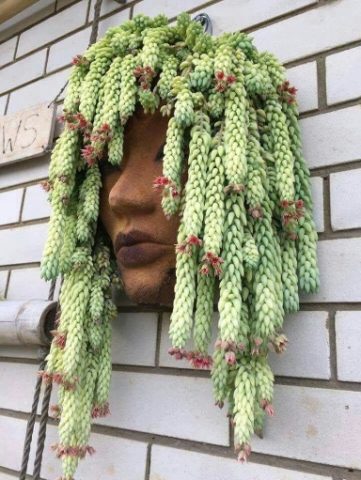
The succulent has completely retained its attractive appearance and blooms readily; the owner of the installation cannot be denied creativity either.
Microclimate
Since succulents do not tolerate high humidity, Morgana sedum should not be kept in the kitchen or bathroom. There is no need to create any special microclimate for it. It grows well at normal humidity in the room or outside.
Watering and fertilizing
Ideally, the soil for Morgana sedum should be slightly moist. It doesn’t like it too dry, but, like any succulent, it can withstand drought. Achieving the ideal is difficult. Under the outer dry layer there may still be quite wet soil.
Regarding watering, you can find different recommendations. Some believe that you need to water the plant when the top layer of soil dries 1.5-2 cm. Other gardeners argue that you need to navigate according to the situation.
The first method is quite complicated, since you will have to dig up the soil, risking damage to the roots. The second is simpler: watering is carried out as soon as the sedum leaves begin to wrinkle.
Sedum planted in open ground is watered approximately once a month. A plant in a pot will need water more often, especially if the sedum is in full sun. Watering may be needed every 10-14 days or even more often in the summer.
For Sedum Morgana, rare but abundant watering is recommended. Frequent, but scanty, harms the plant. A large amount of water washes out mineral salts that are undesirable for the succulent from the soil. But to prevent moisture from stagnating, sedum needs well-drained soil. If the “monkey tail” grows in a pot with a tray, drain the water completely after watering.
Fertilize the sedum once a month. In fact, fertilizing often coincides with watering. But the succulent’s need for nutrients is lower than that of other plants, so the dose of fertilizer recommended by the manufacturer must be diluted by half. Feed Morgan's sedum from March to September. During the dormant period, sedum does not need nutrients at all.

Morgan's sedum leaves can change color not only due to excess sun, but also due to improper fertilization.
Trimming
In the traditional sense, that is, shortening the stems, sedum is not pruned. Otherwise, it will lose its decorative appearance. But sometimes it is necessary to remove bare stems. Then they simply cut off the tops and root them.
Another option when it comes to cutting off the tops and replanting them is rejuvenation. Morgan's sedum only takes 6 years to grow.After this, he degenerates and dies. To avoid this, every few years the tops of the sedum are cut off and re-rooted.

Sedum that degenerates over time is normal for this species
Transfer
Preferably the less often the better. And no more than once every two years. When transplanting, the leaves from the stems will inevitably fall off. And the level of exposure will depend on the skill of the grower. But sometimes a transplant is necessary. How to do this, and why large pots are undesirable, is well shown in the video below:
Can it be grown in open ground?
As long as good drainage is provided, Morgan's sedum will grow in open ground. But only in those regions where there is no sub-zero temperature in winter. There are no such areas in Russia. Even in the southernmost regions winter temperatures drop below zero.
The optimal compromise is: in summer, Morgana sedum grows in pots outside, and in winter it is brought indoors at a temperature of 8-13 °C.
Beneficial features
If we put aside the mysticism copied from Crassula ovalifolia, then Sedum Morgana has almost no beneficial properties. Today it is better to replace the possible analgesic effect with medications. Minor bleeding can be easily stopped by a pressure bandage, but large bleeding should be treated immediately at the hospital. In fact, the only purpose of sedum is to please the eyes of the owner.
Possible problems
Sedum Morgana is not always pleasing to the eye. In addition to diseases and pests, there are other factors that can ruin the appearance of a plant. The main one is the sun.
If the sedum is exposed to midday rays, it may get burned. At best, the leaves will change color from bluish-green to orange-yellow.Although the color will be restored in winter, in summer the burned flower will look sick.
Sometimes the sedum leaves begin to dry out. It may seem like it's due to lack of water, but you need to check the base of the stem with dry leaves. It is possible that the stem rotted due to excess moisture. Drying and dying of leaves that fail to take root is a natural process.
If the pot with Morgana sedum is placed incorrectly, the stems may begin to grow in one direction. The relatively short shoots even rise to catch the sun's rays. Experienced gardeners advise in this case to provide the sedum with additional lighting using a phytolamp.

Sunburn received by sedum due to exposure to the sun can cause its death
Diseases and pests
The succulent, hardened by evolution, is little susceptible to disease. It also has almost no pests, since its natural enemies remain on the American continent. But some problems may arise in Eurasia:
- root rot;
The disease is a mistake of the owner who allowed water to stagnate.
- mold fungi;
The causes of damage are stagnation of water and high air humidity.
- nematodes;
Nematodes are a common occurrence if the sedum was planted in contaminated soil
- aphid.
Aphids are a pest common to all continents
When rot appears, Morgan's sedum is replanted, removing all damaged parts. Or they re-root.
A sign of fungal infection is dark spots on the leaves and stems. The affected parts are cut off and burned.
Nematodes in the soil cannot be eliminated without damaging the plant. Morgan's sedum is restored by cuttings, and the mother part of the succulent is burned.
Aphids are destroyed following the instructions on the insecticide package.But you can use a safer remedy: neem oil. It does not kill aphids, but only prevents them from feeding. Therefore, the effect of the oil will be felt only after a few weeks. Morgan sedum is sprayed with oil from a spray bottle every 10 days until the aphids disappear.
Conclusion
When properly grown and cared for, Morgan's sedum is a very ornamental plant. Since it is unpretentious, it is suitable for beginning gardeners. Also, its advantage is that it “forgives” its owners a long absence from home. You can safely go on vacation without worrying about the condition of the succulent.
